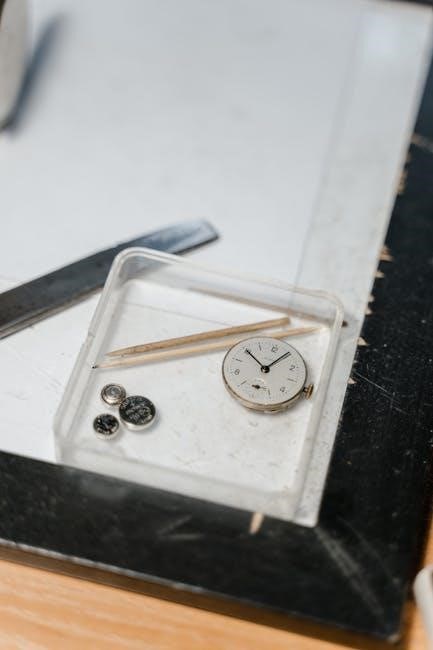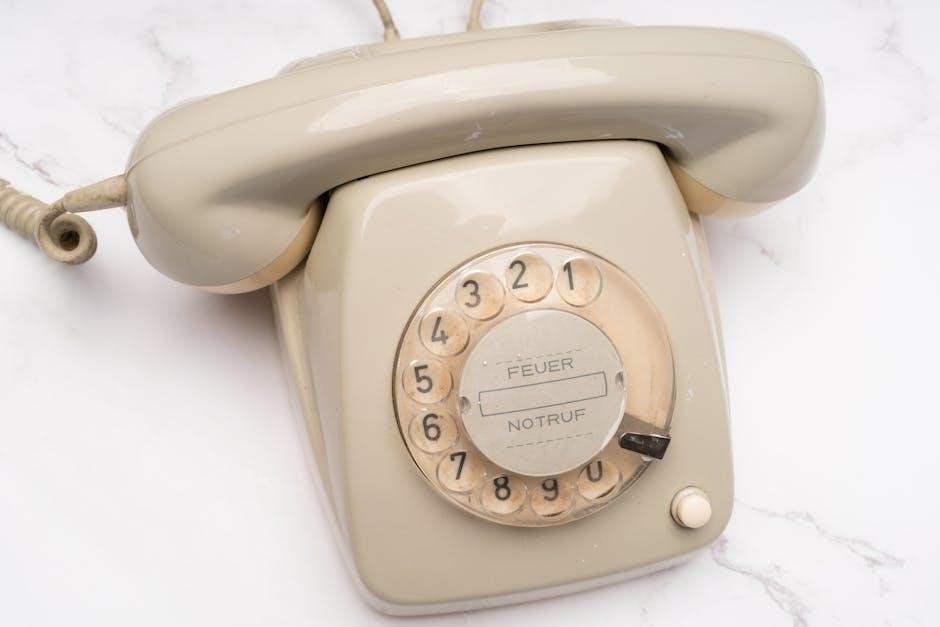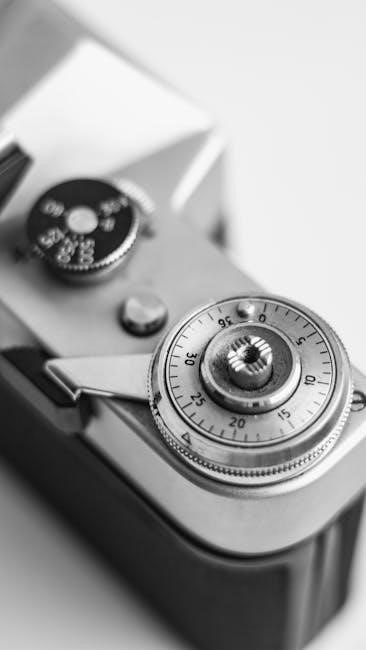Welcome to the Irritrol Rain Dial Manual, your comprehensive guide to understanding and operating the RD-600, RD-900, and RD-1200 irrigation controllers; This manual covers installation, programming, and maintenance tips to ensure efficient watering schedules and system longevity.

1.1 Overview of the Rain Dial Controller
The Rain Dial Controller is a versatile and user-friendly irrigation system designed for residential and small commercial landscapes. Available in models RD-600, RD-900, and RD-1200, it supports 6, 9, and 12 stations respectively, offering flexibility for different-sized properties. The controller features a modular design, allowing easy access to components and programming from any location. Its high-contrast LCD display and intuitive interface, including a rotary dial and push buttons, simplify setup and operation. The system supports up to three independent watering programs, manual operation, and compatibility with rain or soil sensors to optimize water usage. A key feature is its ability to connect to an optional master valve or pump, enhancing functionality for larger systems. With a focus on durability and efficiency, the Rain Dial Controller is a reliable choice for managing irrigation needs effectively.
1.2 Key Features of the Rain Dial Series

The Rain Dial Series stands out for its advanced features tailored to modern irrigation needs. It includes a modular design with a snap-out control module, enabling programming and battery installation without removing the entire unit. The high-contrast LCD display provides clear visibility of settings and programming details. Three independent watering programs allow for customized scheduling based on different zones or plant requirements. Manual operation is straightforward, with a dedicated button for one-time watering without altering programmed schedules. Compatibility with rain and soil sensors enhances water conservation by automatically adjusting irrigation based on environmental conditions. Additional features include a 25-position rotary dial for easy navigation, push buttons for incremental or rapid adjustments, and a master valve/pump terminal for expanded system control. These features collectively ensure efficient, adaptable, and eco-friendly irrigation management, making the Rain Dial Series a top choice for homeowners and professionals alike.
1.3 Models Covered in the Manual (RD-600, RD-900, RD-1200)
This manual provides detailed guidance for three models of the Rain Dial Series: the RD-600, RD-900, and RD-1200. Each model is designed to accommodate different irrigation needs, with the RD-600 supporting up to 6 stations, the RD-900 handling 9 stations, and the RD-1200 managing 12 stations. All models share the same user-friendly interface and core features, ensuring consistency across the series. The manual covers the unique aspects of each model, such as terminal layouts and station capacities, while also providing universal instructions applicable to all three. Whether you’re managing a small residential system with the RD-600 or a larger commercial setup with the RD-1200, this manual offers the necessary insights to optimize performance and customize settings for your specific irrigation requirements.

Installation Guidelines
Mount the controller indoors or outdoors, ensuring proper shielding from direct sunlight and water exposure. Connect the valve wiring and power source securely, following local electrical codes, and install an earth ground device for safety.
2.1 Mounting the Controller Indoors and Outdoors
Mounting the Irritrol Rain Dial controller requires careful planning to ensure optimal performance and durability. For indoor installation, choose a sheltered location like a garage or service room, preferably near a grounded electrical outlet. Outdoor controllers should be installed in a spot protected from direct sunlight and irrigation spray, at least 5 feet away from motorized equipment. Use the provided stainless steel screw to secure the controller to a wall stud, ensuring the screw shaft is exposed by 1/4 inch. For drywall or masonry, use screw anchors for added stability. Hang the controller using the keyhole-shaped slot and secure it with additional screws if needed. Outdoor models may require a junction box installation, adhering to local electrical codes. Ensure the controller is level and easily accessible for programming and maintenance. Proper mounting ensures longevity and reliable operation of your irrigation system.
2.2 Connecting the Valve Control Wiring
Connecting the valve control wiring for your Irritrol Rain Dial controller requires careful planning to ensure proper system operation. Use direct burial wire, such as 18-AWG for shorter distances (up to 800 feet) or 14-AWG for longer runs (up to 2000 feet), to connect the controller to each valve. A separate wire is needed for each valve, and a common (return) wire must be shared among all valves to complete the circuit. Attach one lead of each valve solenoid to its dedicated control wire and the other lead to the common wire. Route the wires through the controller cabinet or conduit, stripping insulation from the ends before securing them to the appropriate terminals. The common wire connects to the VC terminal, while valve wires connect to numbered terminals in sequence. Use waterproof connectors for outdoor splices to prevent corrosion. Ensure all connections are secure and labeled for easy reference, and test the system to confirm proper operation.
2.3 Power Source Connections
Connecting the power source for your Irritrol Rain Dial controller varies depending on whether you have an indoor or outdoor model. For indoor models, use a 24 VAC plug-in transformer. Route the transformer cable through the cabinet’s small hole, tie a knot for strain relief, and connect the wires to the terminals labeled 24 VAC. Plug the transformer into a grounded wall outlet to ensure safe operation. For outdoor models, comply with local electrical codes. Install a junction box with a 1/2 NPT nipple and route 14 AWG wire through the conduit. Connect the wires following color codes: black to black, white to white, and copper to green or yellow for grounding. Ensure the controller is connected to a grounded power source and avoid using it with three-phase power. After installation, test the controller to confirm proper operation. Always keep the outdoor cabinet closed to protect internal components. Ensure all connections are secure and meet safety standards to prevent electrical hazards.
2.4 Earth Ground Device Installation
Installing an earth ground device is crucial for protecting your Irritrol Rain Dial controller from electrical surges, especially in lightning-prone areas. Use a solid copper wire to connect the controller to a grounding source, such as a copper-clad ground rod or metal water pipe. For optimal protection, drive an 8-foot copper-clad ground rod into moist soil near the controller. Attach one end of the copper wire to the ground rod and route it through the cabinet’s access opening. Secure the other end to the terminal labeled “Earth Ground” on the controller. Ensure the wire is tightly connected to prevent loosening over time. This grounding ensures the controller’s surge protection components function effectively. Regularly inspect the ground wire and connections for corrosion or damage, especially in outdoor installations. Proper grounding enhances system safety and reliability, safeguarding your investment against potential electrical hazards. Follow local electrical codes to ensure compliance and optimal protection for your irrigation system.

Programming the Controller
Programming the Irritrol Rain Dial controller allows you to customize irrigation schedules, manual operations, and sensor integration. Use the dial and buttons to set start times, watering days, and special functions effortlessly. Sensors optimize water usage, while templates guide advanced setups for tailored watering plans.
3.1 Setting Up an Irrigation Schedule
Setting up an irrigation schedule with the Irritrol Rain Dial controller is straightforward. Begin by pressing the Manual button to access the programming menu. Use the + and ⎯ buttons to navigate through options. Select the desired station using the rotary Dial, then choose the start time by pressing the Manual button to enter time-setting mode. Adjust the start time using the + and ⎯ buttons. Next, set the watering frequency by cycling through options like daily, every other day, or specific days using the Dial. To set the watering duration, press the Manual button again and adjust the runtime in minutes. Repeat this process for each station to customize their schedules. For added efficiency, integrate a compatible rain or soil sensor to automatically adjust watering based on conditions. Review all settings to ensure accuracy and test the system manually to confirm proper operation.
3.2 Manual Operation and Station Test
Manual operation allows you to water individual stations without altering the programmed schedule. Press the Manual button to activate manual mode. Use the Dial to select the desired station, then press the Manual button again to start watering. The system will run the selected station for its programmed duration. To stop manual operation, press the Manual button once more. For a station test, press and hold the Manual button until the display indicates “Test.” This feature runs each station sequentially for a short duration, allowing you to inspect sprinkler coverage and solenoid operation. Ensure the power source is connected and valves are free of debris for a successful test. This handy feature ensures your irrigation system operates efficiently and identifies any issues before they escalate.
3.3 Using Sensors (Rain/Soil)
Enhance your irrigation system’s efficiency by integrating rain or soil sensors. These sensors prevent unnecessary watering by detecting rainfall or soil moisture levels. For rain sensors, connect the sensor to the controller’s terminal and set the desired sensitivity. During rainfall, the sensor signals the controller to delay watering. For soil sensors, place the probe in the soil and set the moisture threshold. The controller will skip watering when the soil is sufficiently moist. Both sensors are compatible with the Rain Dial series and can be installed alongside the controller. Ensure proper wiring and configuration to maximize water savings. Regularly inspect sensors for accuracy and clean them as needed. By incorporating sensors, you optimize watering schedules, reduce waste, and promote healthier plants. Always refer to the sensor manufacturer’s guidelines for specific installation and calibration instructions.
3.4 Programming Templates and Examples
Programming templates and examples simplify setting up your irrigation schedule. The Rain Dial controller offers pre-set templates for common watering needs, allowing you to customize them for specific zones. For example, a basic template might water lawns every other day, while a garden template waters every three days. Adjust start times, durations, and frequencies to suit your landscape. Use the rotary dial to navigate and modify settings. For instance, set Zone 1 to water at 6 AM for 10 minutes, Zone 2 at 7 AM for 15 minutes, and so on. The controller supports up to three independent programs, enabling tailored watering for different areas. Examples include a summer template with increased frequency and a winter template with reduced watering. Utilize the manual or online guides for step-by-step examples to optimize your irrigation system. These templates and examples ensure efficient and personalized watering schedules for your lawn and garden.

Maintenance and Troubleshooting
Regularly inspect and clean sensors, check wiring connections, and replace fuses if necessary. Reset the controller if issues arise. Refer to the manual for troubleshooting common problems like faulty valves or sensor malfunctions. Contact support for assistance.
4.1 Regular Maintenance Tips
Regular maintenance is crucial for ensuring optimal performance of your Irritrol Rain Dial controller. Start by cleaning the sensors and checking wiring connections for corrosion or damage. Inspect the battery annually and replace it every 5-7 years to prevent memory loss during power outages. Check the fuse and replace it if blown, using a 2A slow-blow fuse to protect against overloads. Additionally, ensure the controller is grounded properly to avoid damage from electrical surges. For outdoor models, keep the cabinet closed and secure to protect internal components from moisture and pests. Finally, review the controller’s schedule and settings periodically to ensure they align with seasonal watering needs. By following these tips, you can extend the lifespan of your irrigation system and maintain efficient operation year-round.
4.2 Common Issues and Solutions
Common issues with the Irritrol Rain Dial controller often relate to wiring, sensor connectivity, or programming errors. If the controller fails to turn on, check the power source and ensure the transformer is properly connected. For incorrect watering times, verify the time and date settings, and ensure the schedule is correctly programmed. If sensors (rain or soil) are not functioning, inspect the connections and ensure no blockages are present. Station-related issues, such as a zone not activating, may require checking valve wiring or replacing faulty solenoids. If the display is unresponsive, try resetting the controller by temporarily removing the battery. For persistent problems, consult the troubleshooting section or contact Irritrol support. Regular maintenance and inspections can help prevent many of these issues, ensuring reliable operation of your irrigation system.
4.3 Repair and Exchange Options
If your Irritrol Rain Dial controller experiences damage or malfunction, several repair and exchange options are available. For defective modules or timers, Irritrol offers repair services or reconditioned replacements through authorized distributors. Additionally, third-party repair services specialize in fixing RD-600, RD-900, and RD-1200 models, ensuring compatibility and functionality. For minor issues, DIY repair kits are available, providing replacement parts like solenoids or circuit boards. If a controller is beyond repair, exchange programs allow you to trade it for a refurbished unit at a reduced cost. Always ensure repairs are done by qualified technicians or use genuine Irritrol parts to maintain warranty validity. For more details, consult the official Irritrol website or contact their customer support team for assistance.

Additional Resources
Explore the Quick Start Guide, video tutorials, and programming templates for easy setup. Visit www.irritrol.com for comprehensive guides, or contact Irritrol support for further assistance and troubleshooting.
5.1 Quick Start Guide
The Quick Start Guide provides an overview of the essential features and setup process for your Irritrol Rain Dial controller. Designed for new users, it simplifies the initial installation and programming steps.
5.2 Video Tutorials and Programming Guides

For a more hands-on approach, video tutorials and detailed programming guides are available to help you master the Irritrol Rain Dial controller. These resources provide step-by-step instructions for setting up irrigation schedules, troubleshooting common issues, and utilizing advanced features like rain and soil sensors. The official Irritrol website offers a comprehensive PDF guide that includes example templates and programming walkthroughs for models RD-600, RD-900, and RD-1200. Additionally, video tutorials cover topics such as manual operation, station testing, and integrating sensors for optimal water savings. These resources are designed to ensure you get the most out of your irrigation system while maintaining ease of use. Whether you’re a novice or experienced user, these guides will help you customize and refine your watering programs efficiently. Visit the Irritrol website to access these tools and enhance your controller’s performance.
5.3 Contact Information and Support
For assistance with your Irritrol Rain Dial controller, reach out to the dedicated support team. Visit the official Irritrol website for contact details, including phone numbers and email addresses. The site also offers a wealth of resources, such as FAQs, user manuals, and troubleshooting guides. If you need repair services for models like RD-600, RD-900, or RD-1200, authorized service providers are available to fix and recondition controllers. Additionally, the Rain Dial-R Quick Start Guide and other downloadable PDFs provide quick solutions for common issues; For further help, explore video tutorials and programming examples on the Irritrol support page. Ensure your irrigation system runs smoothly with direct access to expert assistance and comprehensive support materials.
